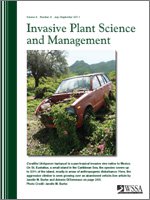Quantification of interference with biological control agents can provide support for anecdotal claims of success or failure of agent establishment and efficacy. This study was initiated because of observed predation of cinnabar moth larvae by carpenter ants when releasing larvae for the control of tansy ragwort, an invasive plant in Montana. Biotic and abiotic factors were compared among three sites with historically variable moth population establishment. Two experiments were developed to (1) observe and document insect activity, predation, or disappearance on tansy ragwort stems either protected or accessible to ants; and (2) quantify the effects of ant exclusion on herbivory of tansy ragwort. Site comparisons indicated that ant colony density was highest at the driest of three sites, and, interestingly, no ant colonies were detected at the site with higher observed numbers of moth larvae and adults and lower densities of tansy ragwort. Available substrate (logs and stumps) for ant colonization did not differ between the three sites. In the ant exclusion experiments, a larger number of larvae were missing on plants accessible to ants (63%) compared with plants where ants were excluded (39%) after 36 h. Direct observation of predation of larvae by carpenter ants accounted for 9% of missing larvae on stems accessible to ants. Larvae were able to consume 81% of original flowers or buds on ant-excluded stems, compared with 18% consumption on ant-accessible stems, suggesting that ant predation could limit the efficacy of cinnabar moth larvae. These results provide one of many possible explanations for the anecdotal observations of large, persistent populations of cinnabar moths in moist areas. This work emphasizes the importance of post-release observation and monitoring to detect and, ideally, quantify factors to support anecdotal perceptions regarding the fate and subsequent efficacy of insect biological-control agents.
Nomenclature: Cinnabar moth; Tyria jacobaeae L.; carpenter ant; Camponotus spp.; tansy ragwort; Senecio jacobaea L.
Interpretive Summary: Biological control insects are often released into the environment and left unmonitored for long periods. As a result, the degree to which insects establish viable populations and the biotic and abiotic factors that affect establishment are often unknown. In this study, we show that carpenter ants could pose a threat to cinnabar moth larvae in forests in Montana. Preliminary data suggest that dry sites may foster higher numbers of carpenter ants colonies and that carpenter ants do attack and kill cinnabar moth larvae. When cinnabar moth larvae are being redistributed for biocontrol, dry sites with a higher probability of carpenter ant colonies should be avoided. Focusing efforts in areas with reduced probability of ant presence will lead to a decreased chance of larva predation, allowing for increased population growth at safer sites from which moth populations may acquire higher populations and then spread naturally to less-suitable sites with higher ant densities.





